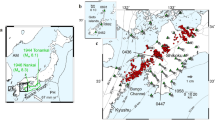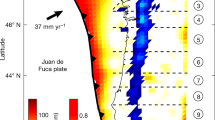Abstract
Slow-slip events, or ‘silent earthquakes’, have recently been discovered in a number of subduction zones including the Nankai trough1,2,3 in Japan, Cascadia4,5, and Guerrero6 in Mexico, but the depths of these events have been difficult to determine from surface deformation measurements. Although it is assumed that these silent earthquakes are located along the plate megathrust, this has not been proved. Slow slip in some subduction zones is associated with non-volcanic tremor7,8, but tremor is difficult to locate and may be distributed over a broad depth range9. Except for some events on the San Andreas fault10, slow-slip events have not yet been associated with high-frequency earthquakes, which are easily located. Here we report on swarms of high-frequency earthquakes that accompany otherwise silent slips on Kīlauea volcano, Hawaii. For the most energetic event, in January 2005, the slow slip began before the increase in seismicity. The temporal evolution of earthquakes is well explained by increased stressing caused by slow slip, implying that the earthquakes are triggered. The earthquakes, located at depths of 7–8 km, constrain the slow slip to be at comparable depths, because they must fall in zones of positive Coulomb stress change. Triggered earthquakes accompanying slow-slip events elsewhere might go undetected if background seismicity rates are low. Detection of such events would help constrain the depth of slow slip, and could lead to a method for quantifying the increased hazard during slow-slip events, because triggered events have the potential to grow into destructive earthquakes.
This is a preview of subscription content, access via your institution
Access options
Subscribe to this journal
Receive 51 print issues and online access
$199.00 per year
only $3.90 per issue
Buy this article
- Purchase on Springer Link
- Instant access to full article PDF
Prices may be subject to local taxes which are calculated during checkout





Similar content being viewed by others
References
Hirose, H., Hirahara, K., Kimata, F., Fujii, N. & Miyazaki, S. A slow thrust slip event following the two 1996 Hyuganada earthquakes beneath the Bungo Channel, southwest Japan. Geophys. Res. Lett. 26, 3237–3240 (1999)
Ozawa, S. et al. Detection and monitoring of ongoing aseismic slip in the Tokai region, central Japan. Science 298, 1009–1012 (2002)
Miyazaki, S., McGuire, J. & Segall, P. A transient subduction zone slip episode in southwest Japan observed by the nationwide GPS array. J. Geophys. Res. 108, 2087–2087 (2003)
Dragert, H., Wang, K. L. & James, T. S. A silent slip event on the deeper Cascadia subduction interface. Science 292, 1525–1528 (2001)
Miller, M. M., Melbourne, T., Johnson, D. J. & Sumner, W. Q. Periodic slow earthquakes from the Cascadia subduction zone. Science 295, 2423–2423 (2002)
Kostoglodov, V. et al. A large silent earthquake in the Guerrero seismic gap, Mexico. Geophys. Res. Lett. 30, 1807–1810 (2003)
Rogers, G. & Dragert, H. Episodic tremor and slip on the Cascadia subduction zone: The chatter of silent slip. Science 300, 1942–1943 (2003)
Obara, K., Hirose, H., Yamamizu, F. & Kasahara, K. Episodic slow slip events accompanied by non-volcanic tremors in southwest Japan subduction zone. Geophys. Res. Lett. 31, L23602, doi:10.1029/2004GL020848 (2004)
Kao, H. et al. A wide depth distribution of seismic tremors along the northern Cascadia margin. Nature 436, 841–844 (2005)
Linde, A., Gladwin, M., Johnston, M., Gwyther, R. & Bilham, R. A slow earthquake sequence on the San Andreas fault. Nature 383, 65–68 (1996)
Cervelli, P., Segall, P., Johnson, K., Lisowski, M. & Miklius, A. Sudden aseismic fault slip on the south flank of Kilauea volcano. Nature 415, 1014–1018 (2002)
Segall, P., Desmarais, E., Miklius, A. & Okubo, P. (Nearly) silent earthquakes on volcanoes. Trans. AGU Fall Meet. Suppl. 86(52), G43A-01 (2005)
Brooks, B., Foster, J., Bevis, M., Frazer, L. & Behn, M. Slow earthquakes on the flank of Kilauea volcano, Hawaii. Trans. AGU Fall Meet. Suppl. 86(52), G53B-0879 (2005)
Dieterich, J. A constitutive law for rate of earthquake production and its application to earthquake clustering. J. Geophys. Res. 99, 2601–2618 (1994)
Got, J., Frechet, J. & Klein, F. Deep fault plane geometry inferred from multiplet relative relocation beneath the south flank of Kilauea. J. Geophys. Res. 99, 15375–15386 (1994)
Got, J.-L. & Okubo, P. New insights into Kilauea's volcano dynamics brought by large scale relative relocation of microearthquakes. J. Geophys. Res. 108, 2337–2350 (2003)
Hansen, S., Thurber, C., Mandernach, M., Haslinger, F. & Doran, C. Seismic velocity and attenuation structure of the East Rift Zone and south flank of Kilauea volcano, Hawaii. Bull. Seismol. Soc. Am. 94, 1430–1440 (2004)
Waldhauser, F. & Ellsworth, W. L. A double-difference earthquake location algorithm: method and application to the Northern Hayward Fault, California. Bull. Seismol. Soc. Am. 90, 1353–1368 (2000)
Nettles, M. & Ekstrom, G. Long-period source characteristics of the 1975 Kalapana, Hawaii, earthquake. Bull. Seismol. Soc. Am. 94, 422–429 (2004)
Owen, S. & Burgmann, R. An increment of volcano collapse: Kinematics of the 1975 Kalapana, Hawaii, earthquake. J. Volcan. Geotherm. Res. 150, 163–185 (2006)
Ma, K.-F., Kanamori, H. & Satake, K. Mechanism of the 1975 Kalapana, Hawaii, earthquake inferred from tsunami data. J. Geophys. Res. 104, 13153–13168 (1999)
Delaney, P. et al. Volcanic spreading at Kilauea, 1976–1996. J. Geophys. Res. 103, 18003–18023 (1998)
Owen, S. et al. Rapid deformation of Kilauea volcano: Global positioning system measurements between 1990 and 1996. J. Geophys. Res. 105, 18983–18998 (2000)
Liu, Y. & Rice, J. R. Aseismic slip transients emerge spontaneously in 3d rate and state modeling of subduction earthquake sequences. J. Geophys. Res. 110, B08307, doi:10.1029/2004JB003424 (2005)
Kato, N. Interaction of slip on asperities: Numerical simulation of seismic cycles on a two-dimensional planar fault with nonuniform frictional property. J. Geophys. Res. 109, B12306, doi:10.1029/2004JB003001 (2004)
Segall, P., Cervelli, P. & Miklius, A. Insights from deformation during the Pu'u O'o eruption of Kilauea volcano. Eos Trans. AGU Fall Meet. Suppl. 83 (47), abstr. V62C-02 (2002)
Cervelli, P., Murray, M., Segall, P., Aoki, Y. & Kato, T. Estimating source parameters from deformation data, with an application to the March 1997 earthquake swarm off the Izu Peninsula, Japan. J. Geophys. Res. 106, 11217–11238 (2001)
Acknowledgements
We gratefully acknowledge C. Thurber for providing seismic data from the University of Wisconsin 1999/2000 experiment, P. Okubo for help with HVO seismic data, the University of Hawaii for exchange of GPS data, and D. Swanson for editorial comments. Author Contributions P.S. and E.K.D. jointly modelled GPS and seismic data. P.S. derived the seismicity rate results. D.S. relocated the earthquakes. A.M. processed GPS data and first detected the events studied. P.C. helped with time-dependent slip inversion. All authors discussed results and commented on manuscript.
Author information
Authors and Affiliations
Corresponding author
Ethics declarations
Competing interests
Reprints and permissions information is available at npg.nature.com/reprintsandpermissions. The authors declare no competing financial interests.
Rights and permissions
About this article
Cite this article
Segall, P., Desmarais, E., Shelly, D. et al. Earthquakes triggered by silent slip events on Kīlauea volcano, Hawaii. Nature 442, 71–74 (2006). https://doi.org/10.1038/nature04938
Received:
Accepted:
Issue Date:
DOI: https://doi.org/10.1038/nature04938
This article is cited by
-
Cascading events during the 1650 tsunamigenic eruption of Kolumbo volcano
Nature Communications (2023)
-
The 2020 Perachora peninsula earthquake sequence (Εast Corinth Rift, Greece): spatiotemporal evolution and implications for the triggering mechanism
Acta Geophysica (2022)
-
Activated seismicity by strain rate change in the Yaeyama region, south Ryukyu
Earth, Planets and Space (2018)
-
Aseismic transient during the 2010–2014 seismic swarm: evidence for longer recurrence of M ≥ 6.5 earthquakes in the Pollino gap (Southern Italy)?
Scientific Reports (2017)
-
Triggered earthquakes suppressed by an evolving stress shadow from a propagating dyke
Nature Geoscience (2015)
Comments
By submitting a comment you agree to abide by our Terms and Community Guidelines. If you find something abusive or that does not comply with our terms or guidelines please flag it as inappropriate.



